
PJB-2024-652
SUCCESSFUL APPROACHES FOR TEAK MICROPROPAGATION
MUHAMMAD ILYAS KHOKHAR1
Abstract
Teak micropropagation provides an efficient method for large-scale production of genetically identical plants but faces several challenges. These include a high endogenous bud infection rate, low shoot initiation, hyperhydricity, limited shoot multiplication, slow shoot elongation, less root formation and excessive phenolic compounds exudation which are inherent to the woody nature of teak plants. This study was employed teak shoot buds as explant sources to address these challenges and develop a successful propagation protocol using phytohormones, antioxidant, and detergents. The result showed that maximum 21% buds were survived when surface sterilized with 0.1% mercuric chloride for 3 minutes while phenolic compounds were controlled with 0.5mg/L activated charcoal (ACC) in primary medium (PM) and shoot initiation medium (SIM). The highest bud sprouting rate (37%) was achieved on modified Murashige and Skoog (mMS) medium supplemented with 2mg/L 6-Benzylaminopurine (BAP) after 16 days. Maximum shoot elongation of 12.3 cm was produced after 30 days at mMS medium with 1mg/L BAP. Maximum shoot multiplication, with 9 shoots per explant, was achieved after 26 days when a shoot shifted on mMS + 0.75mg/L BAP. Root initiation reached a maximum success rate of 53% after 17 days when single shoot was cultured on mMS supplemented with 1mg/L Indole Butyric Acid (IBA).
To Cite this article:


